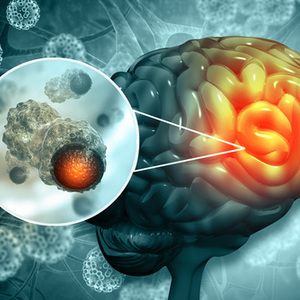
What is a brain tumour?
A brain tumour is a tumour that is located in the area of the brain or the meninges. Doctors distinguish between benign and malignant tumours. Brain tumours can occur at any age and can affect men, women and children. According to current medical knowledge, there is neither early detection nor prevention of brain tumours.
What are the typical symptoms of a brain tumour?
Most often, a brain tumour manifests itself without prior warning and may be noticeable through non-specific symptoms such as headaches, (noticeable) changes in behaviour, epileptic seizures, nausea and vomiting or visual, speech or brain performance disorders. These symptoms occur with both malignant and benign tumours. However, some brain tumours do not cause any symptoms at all for a long time, which is why they remain undetected for a long time.
How is a brain tumour diagnosed?
The suspicion of a brain tumour can usually be confirmed after a neurological examination. In order to finally diagnose the brain tumour without a doubt, doctors use a computer tomography (CT) or a magnetic resonance imaging (MRI). A CT uses X-rays to produce cross-sectional images of the brain and shows whether it is a brain tumour or, for example, a calcification or haemorrhage. In contrast to a CT, an MRI is more detailed and is therefore also able to diagnose smaller tumours.
For the effective treatment of a brain tumour, it is necessary to carry out a fine tissue examination of the tumour under the microscope. To do this, the neurosurgeon takes a tissue sample by means of a surgical procedure or a biopsy. The neuropathologist then determines whether the tumour is benign or malignant. The neuropathologist then determines the grade of malignancy of the tumour. The following four grades are distinguished:
- Grade I: The tumour is benign and grows slowly.
- Grade II: The tumour is no longer entirely benign.
- Grade III: The tumour is malignant.
How is the brain tumour treated?
The doctor always adapts the treatment method to the individual patient. It depends not only on the grade of the tumour, but also on where exactly the tumour has formed in the area of the brain. Depending on the case, the tumour can be removed surgically or treated with chemotherapy or radiotherapy, a TTF (electric tumour therapy field), immunotherapy or a combination of different methods.
The chances of recovery for benign brain tumours that could be removed by surgery are usually very good. Whether the tumour is better treated with chemotherapy and/or radiotherapy is decided by the doctor on the basis of the fine tissue findings (histology). In some cases, treatment approaches that are currently still in the trial phase can also be used. These include, for example, treatment methods from radiosurgery.
Aftercare of brain tumours by neurological, oncological or neuro-oncological rehabilitation
The treatment of brain tumours that have led to neurological disorders is followed by outpatient, partial inpatient or inpatient rehabilitation. The successful removal of a benign tumour is usually followed by neurological rehabilitation. The treatment of malignant tumours is followed by oncological or neurological rehabilitation.
During neurological rehabilitation, the mental deficits caused by the tumour, the impairment of fine motor skills as well as paralysis and balance and speech disorders are diagnosed and treated. Oncological rehabilitation, on the other hand, focuses on strengthening the patient's health and psychology. Neuro-oncological rehabilitation, on the other hand, combines both approaches and also offers physiotherapy and occupational therapy as well as speech therapy and physical therapies.
